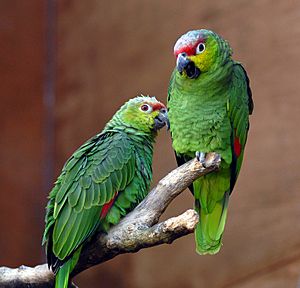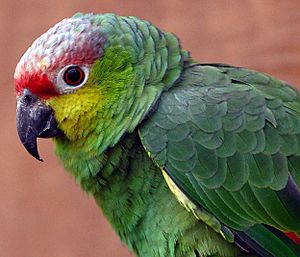Lilacine amazon facts for kids
Quick facts for kids Lilacine amazon |
|
|---|---|
 |
|
| Conservation status | |
| Scientific classification |
|
| Kingdom: | Animalia |
| Phylum: | Chordata |
| Class: | Aves |
| Order: | Psittaciformes |
| Family: | Psittacidae |
| Genus: | Amazona |
| Species: | |
| Subspecies: |
A. a. lilacina
|
| Trinomial name | |
| Amazona autumnalis lilacina (Lesson, 1844)
|
|
| Synonyms | |
|
|

The Lilacine Amazon (Amazona autumnalis lilacina) is a beautiful amazon parrot. It is also known as the Ecuadorian Red-lored Amazon. This bird lives in Ecuador in South America.
Many experts, like the IOC World Bird List, see it as a type of red-lored amazon (a subspecies). However, groups like Birdlife International and the International Union for Conservation of Nature (IUCN) think it's a separate species, Amazona lilacina. The IUCN lists it as critically endangered. This means it is very close to disappearing from the wild.
Lilacine Amazons are usually smaller than their relatives. They have a black beak and softer colors. People often say they make good companion parrots. This is because they are gentle, loving, and have a nice temperament.
Contents
Discover the Lilacine Amazon's Look
The Lilacine Amazon is a small parrot. It grows to be about 34 cm (13 inches) long. Most of its feathers are green. Like the Red-lored Amazon, it has red feathers around its eyes (called lores). It also has yellow cheeks.
You can tell it apart by its completely black beak. Also, the feathers on its head (crown) have pretty lilac-colored tips.
Lilacine Amazon Behavior and Habits
The Lilacine Amazon is known for being gentle and a bit shy. In the wild, it tries to avoid trouble. If it senses danger, it will hide in nearby trees or bushes. It waits until the danger has passed.
These parrots usually live in small to medium-sized groups. They roost (sleep) together at night. Many birds in the group form pairs and stay together for life. You will often see them flying in pairs.
What Lilacine Amazons Eat
The Lilacine Amazon mainly eats fruits, nuts, berries, and seeds. Like most parrots, it has a very strong beak. Its clever tongue also helps it break down and eat many different kinds of food.
Lilacine Amazon Reproduction and Life Cycle
Lilacine Amazons are ready to have babies when they are three or four years old. Like most parrots, they mate with only one partner for life (they are monogamous). They also build their nests inside holes in trees (they are cavity nesters).
The female parrot will lay two to four eggs. She sits on them for about three weeks to keep them warm. The young birds leave the nest (fledge) about two months after they hatch. The male parrot helps feed the female and chicks. He eats extra food and then brings it back up (regurgitates) for them.
Where Lilacine Amazons Live
The Lilacine Amazon lives in the tropical dry forests of western Ecuador. This area is north of the Gulf of Guayaquil. Their home also reaches into the Nariño Department in the very southwest of Colombia. This is right next to the Ecuadorian border. Here, their territory meets that of another parrot type, A. a. salvini.
Lilacine Amazons as Pets
Lilacine Amazons have become very popular as companion parrots. People describe them as intelligent, gentle, loving, and loyal. When they are kept as pets (captivity), they enjoy being with people. They often form a very strong bond with their owners.
They are not known for being amazing talkers. However, most of them can learn to copy at least a few words or phrases. The World Parrot Trust suggests that a Lilacine Amazon should have a cage at least 3 meters (10 feet) long.
The Lilacine Amazon has only recently become common in the pet trade. Before, they were quite rare. At least one special program in Europe has been set up to help them have babies in captivity. This helps increase their numbers.
See also
 In Spanish: Loro de lores rojas para niños
In Spanish: Loro de lores rojas para niños


